Recent Articles
Popular Makes
Body Types
2019 Toyota RAV4 Road Test and Review
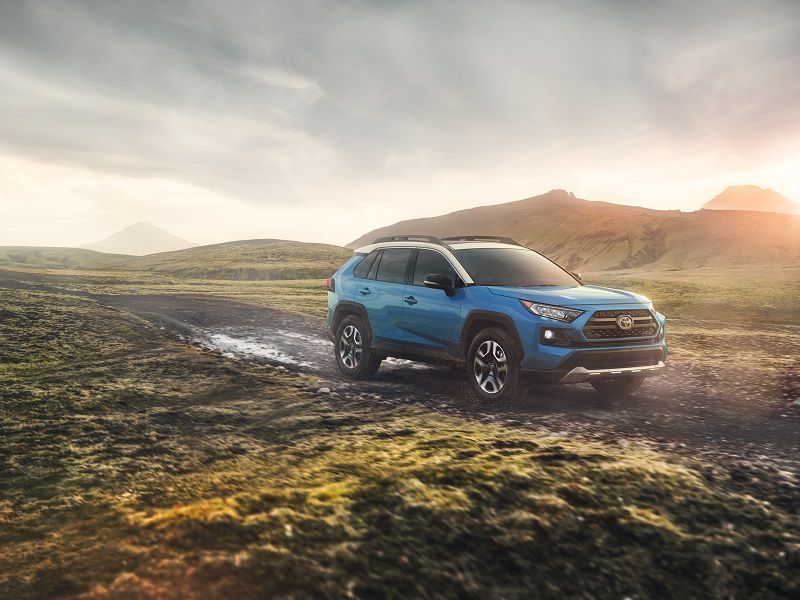
2019 Toyota RAV4 Blue Off Road Front Three Quarter ・ Photo by Toyota
This is the moment of the compact crossover vehicle, and one of the leading examples is all new for 2019. The Toyota RAV4 is not only one of the best-selling crossovers on the market, but it is also one of the best-selling vehicles overall. With 407,594 sales in 2017, and on the way to exceeding that milepost in 2018, RAV4 is by far Toyota’s best-selling model, so a major makeover is a very important landmark.
The first-generation RAV4 (Recreational Active Vehicle with 4WD) hit the US as a 1996 model, followed by the second gen in 2001, the third in 2006, and the fourth in 2013. The compact crossover has grown and matured over the years, shedding its “cute-ute” look with body cladding and a side-hinged tailgate with an exterior-mounted full-size spare tire, and replacing it with a more mature look with a top-hinged liftgate and compact spare hidden beneath the cargo floor.
What is it?
The RAV4 is a compact crossover vehicle. It slots into Toyota’s SUV lineup between the subcompact C-HR and mid-size Highlander crossovers, and below the 4Runner, Sequoia, and Land Cruiser SUVs. The RAV4 is built on the Toyota New Global Architecture (TNGA-K) platform, the same layout that underlies the Camry and Avalon sedans, along with the Lexus ES.
This platform is a frameless unibody design and mounts the engine transversely in the front. Compared to last year's RAV4, the new model has a longer wheelbase (105.9 inches vs. 104.7 inches) and wider track (62.6 to 63.7 inches vs. 61.4 to 61.8 inches). It also has substantially more ground clearance than before (8.4 to 8.6 inches vs. 6.1 to 6.5 inches), and it has become nearly an inch wider (73.0 to 73.4 inches vs. 72.6 inches). Approach and departure angles have decreased slightly (19/21 for 2019 vs. 28/21 to 23 for 2018). Toyota hasn’t reported a breakover angle for the RAV4.
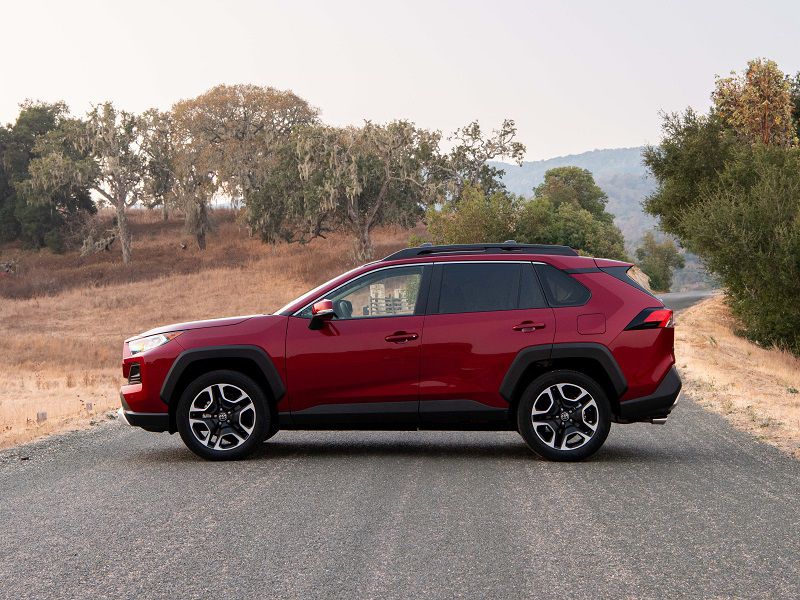
Photo by Toyota
Design
Toyota says that the goal with RAV4’s redesign was to convey “Adventure & Refinement.” OK. For those RAV4 spotters out there, the new RAV4 stands out for more chiseled details. The wheel arches, formerly smooth arcs, have been flattened at the top for a more truckish appearance, housing 17-inch wheels (on the LE and XLE trims) or 19-inch wheels (available on the XLE and above) wheels.
Likewise, the front fascia is more linear, with a new grille that is almost flat and perpendicular to the road. Expressive standard multi-LED headlights squint out from the fenders, and fog lamps are deeply inset into lower openings (XLE and above). At the back, a top-hinged liftgate wears big rectangular LED taillights that echo the ones from big brother 4Runner. Inside, a very nicely balanced dashboard with a horizontally layered appearance and centrally mounted touchscreen display is, per the design brief, very refined.
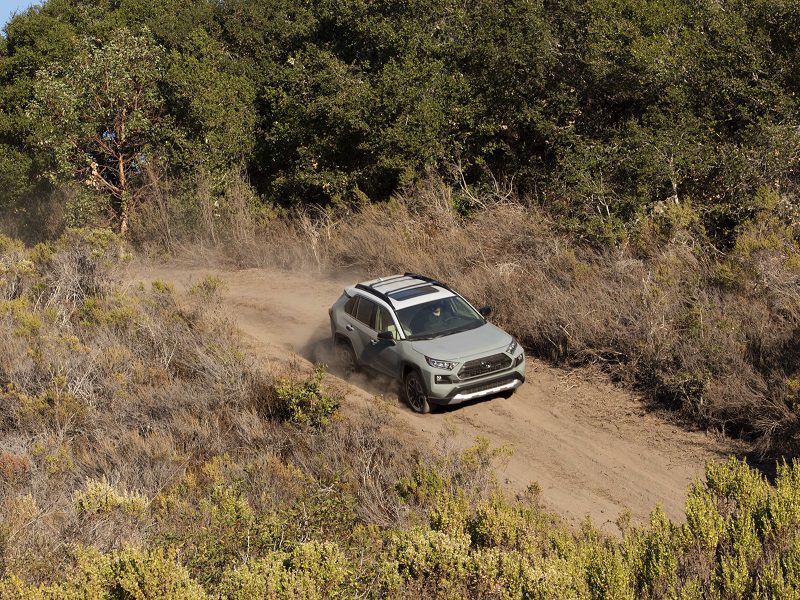
Photo by Toyota
Infotainment
Toyota has included its Entune 3.0 Audio system in even the base RAV4 LE. The base system on the LE, XLE, and XLE Premium includes a 7-inch touchscreen, six speakers, AM/FM radio, Scout GPS Link with a three-year trial period, Amazon Alexa, Bluetooth audio streaming and hands-free, Siri Eyes Free, and a new feature for the RAV4: Apple CarPlay. Android Auto is still not available. Wi-Fi Connect with up to 2 GB is also included with a six-month trial from Verizon.
Entune 3.0 Audio Plus is standard on the Adventure trim, and upgrades to an 8-inch touchscreen and adds SiriusXM satellite radio with a three-month trial. Entune 3.0 Audio Plus with Dynamic Navigation is standard on the Limited. JBL with Clari-Fi is a premium option ($1,620 on the XLE Premium, XSE, and Adventure, $580 on the Limited) that is well worth the price.
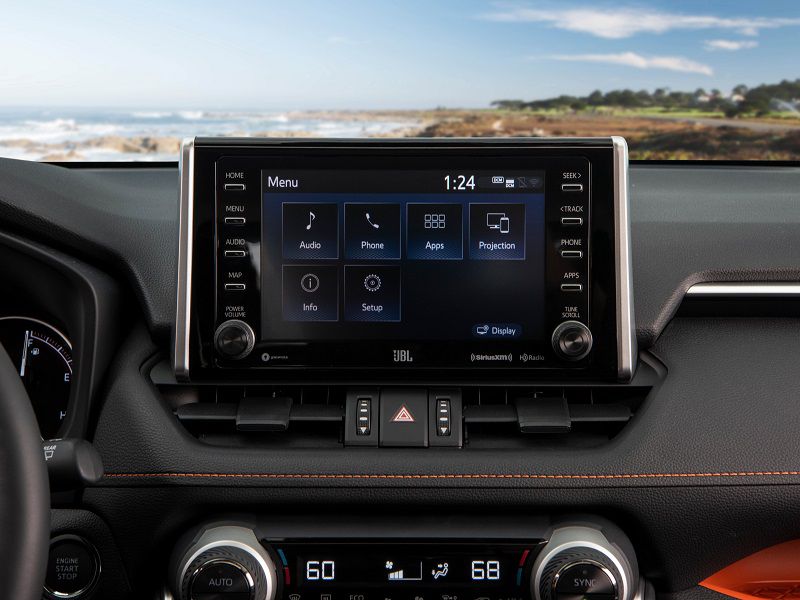
Photo by Toyota
About the Gasoline-Only Powertrain
The RAV4's new 2.5-liter inline four-cylinder Dynamic Force gasoline engine is tuned to produce 203 horsepower and 184 lb-ft of torque. It uses direct gasoline injection, is naturally aspirated (non-turbo), and runs on 87-octane regular unleaded gas. It has four valves per cylinder and dual overhead camshafts, each with variable valve timing. A new Direct Shift eight-speed automatic transmission replaces the old six-speed automatic. No manual transmission option is offered.
With front-wheel drive, the gasoline RAV4 is rated to achieve 26-27 mpg in the city, 34 mpg on the highway, and 29 mpg combined. With all-wheel drive, the ratings are a tick lower at 26 mpg city/33 mpg highway/29 mpg combined. The Adventure and Limited grades with AWD slip a little farther, down to 24 mpg city/32 mpg highway/27 mpg combined.
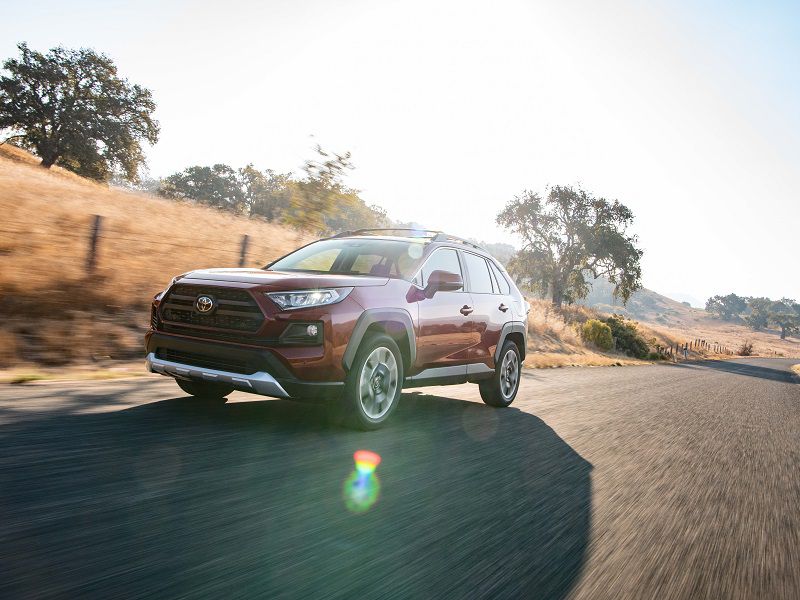
Photo by Toyota
About the Hybrid Gasoline-Electric Powertrain
The hybrid RAV4 models also use a 2.5-liter inline four-cylinder Dynamic Force gasoline engine that uses 87-octane regular gas, but here it's tuned to produce 176 hp and 163 lb-ft of torque. An electric motor powered by a nickel-metal hydride battery pack can send 118 hp and 149 lb-ft of torque to the front wheels and 54 hp and 89 lb-ft of torque to the rear wheels. Together, the engine and motor are rated to produce 219 combined net hp.
An electronically controlled continuously variable automatic transmission conveys the power from the engine to the wheels and modulates the output of the electric motor. The RAV4 hybrid models — offered only with all-wheel-drive — get EPA fuel economy ratings of 41 mpg in the city, 37 mpg on the highway, and 39 mpg combined.
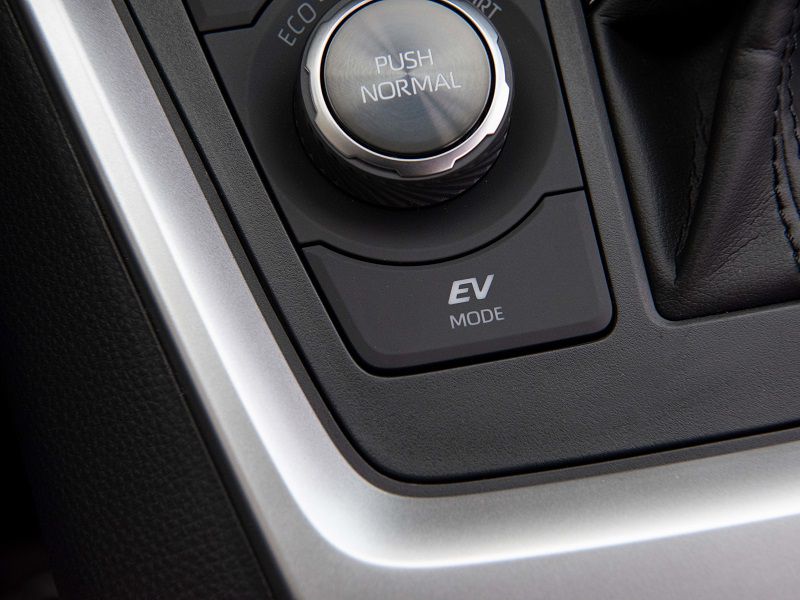
Photo by Toyota
Suspension, Steering, and Drive Modes
The RAV4 uses four-wheel independent suspension, typical of crossover vehicles. Up front, you’ll find MacPherson struts with a stabilizer bar, while out back a trailing wishbone-style multi-link rear setup with a stabilizer bar handles the bumps and ruts. XSE HV models get a slightly sportier set of struts and dampers. All RAV4s use electric power steering with a motor mounted on the rack of the rack-and-pinion system.
Gasoline-only all-wheel drive models come with Multi-Terrain Select, a system that allows drivers to shift on the fly from standard to Mud & Sand or Rock & Dirt modes for improved off-road performance. Hybrid models come with a Trail Mode that can brake a spinning wheel and send torque to the wheel with traction.

Photo by Toyota
Safety
The RAV4 will come with standard Toyota Safety Sense 2.0. The safety suite includes a pre-collision system with pedestrian detection, full-speed radar cruise control, a lane-departure alert with steering assist, automatic high beams, lane-tracing assist, and road-sign assist. Most trim levels also get standard blind-spot monitoring with a rear cross-traffic alert and rear cross-traffic braking — except the LE, where these features are optional. The XLE and above are available with "intelligent clearance sonar," which is standard on the Limited.
Eight airbags are standard on all models, along with Toyota’s Star Safety System. Hill Descent Control and Trailer Sway Control are also standard, and a nifty digital rearview mirror system, which can replace the reflected view with an image captured by a rear-mounted camera, is available.
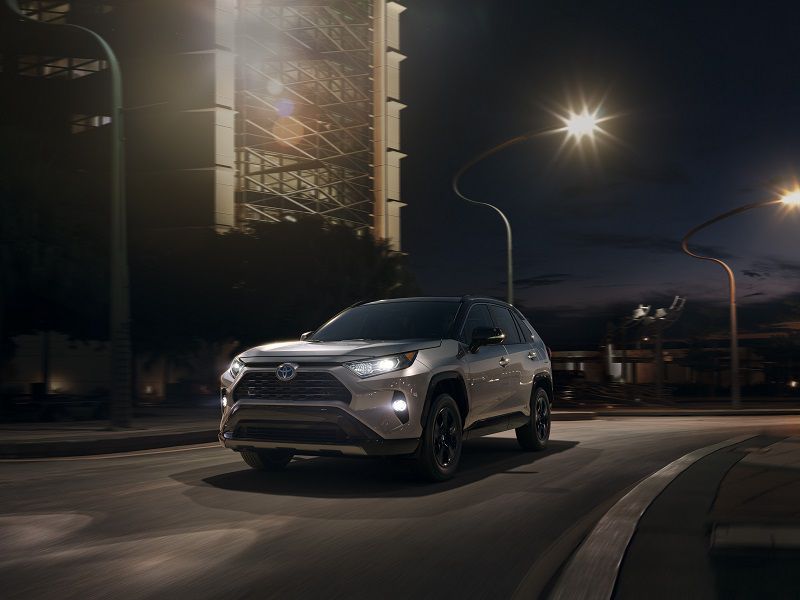
Photo by Toyota
On the Road
Toyota made multiple configurations of gas and hybrid RAV4 models available to drive during the launch event that we attended. The new gas engine is lively, though it does sound a little thrashy when pushed hard. The eight-speed automatic transmission is well-matched to the engine’s output. All-wheel drive gas models get Dynamic Torque Vectoring, a system that can direct up to 50 percent of the engine’s output to the rear wheels and shift it from side to side, depending on the vehicle’s needs, improving cornering feel and handling.
Hybrid models are even livelier than the gas-only models, and the gas engine never sounds tortured under heavy acceleration. Hybrid operation is completely transparent, thanks in part to a very smooth start/stop system for the gas engine. Both gas and hybrid models deliver a dose of that desirable ingredient: fun-to-drive.
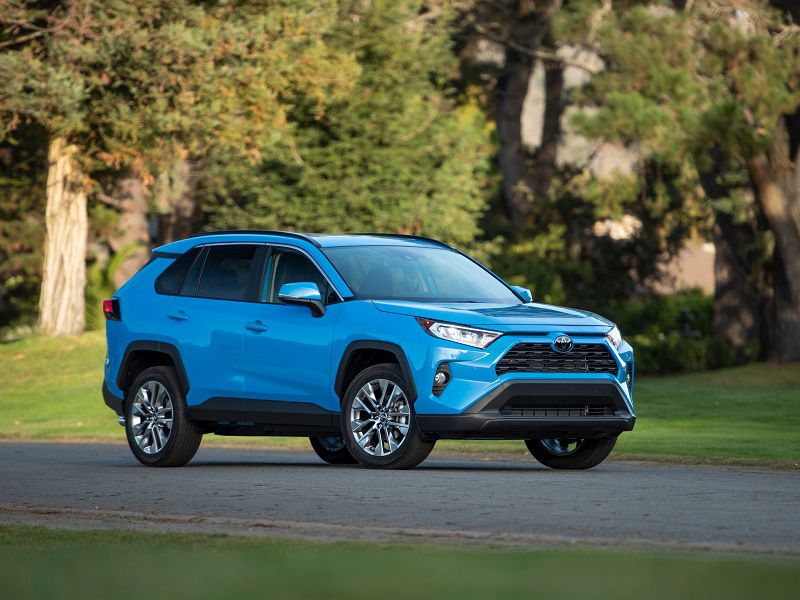
Photo by Toyota
Models, Trim Levels, Pricing and Packages
For 2019, the Toyota RAV4 will be available in 13 different trim levels, including four hybrid examples. Gasoline-only FWD models start at $25,500 for the LE, $27,300 for the XLE, $29,500 for the XLE Premium, and $33,500 for the Limited. Add $1,400 to each for the AWD gasoline models. The Adventure is available only with all-wheel drive and a gas-only engine, and it starts at $32,900. The hybrid range starts with the LE at $27,700, the XLE at $29,500, the XSE at $33,700, and the Limited at $35,700. All hybrid models are AWD, and add just $800 per trim level above their respective gasoline-only AWD models.
Available packages include an Advanced Technology Package, Convenience Package and Weather Prep Package. Standalone options include a two-tone roof on the Adventure model ($500), Moonroof and Panoramic Moonroof, Premium Audio with Navigation, and more.
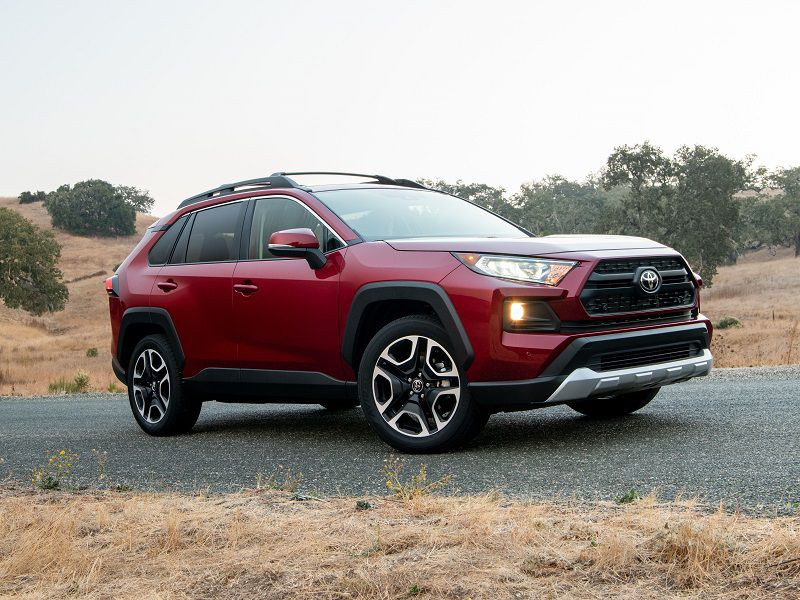
Photo by Toyota
Final Thoughts
The RAV4 has taken a big leap into its fifth generation, and it should attract even more buyers without abandoning its loyal followers. A crowded field of competitors also have merit, including the Honda CR-V, Nissan Rogue, Subaru Forester, Chevrolet Equinox, Hyundai Tucson, Kia Sportage, Ford Escape, and Mazda CX-5.
The winning configuration for the RAV4 is the XLE Hybrid. Starting at $29,500, it comes well-equipped and has standard all-wheel drive. There's the great standard safety suite, and 39 mpg combined is nothing to sneeze at. Sure, the Adventure trim level is a little bit cooler-looking and the XSE is marginally sportier, but the amount of technology and level of efficiency on XLE Hybrid is very impressive for the price.
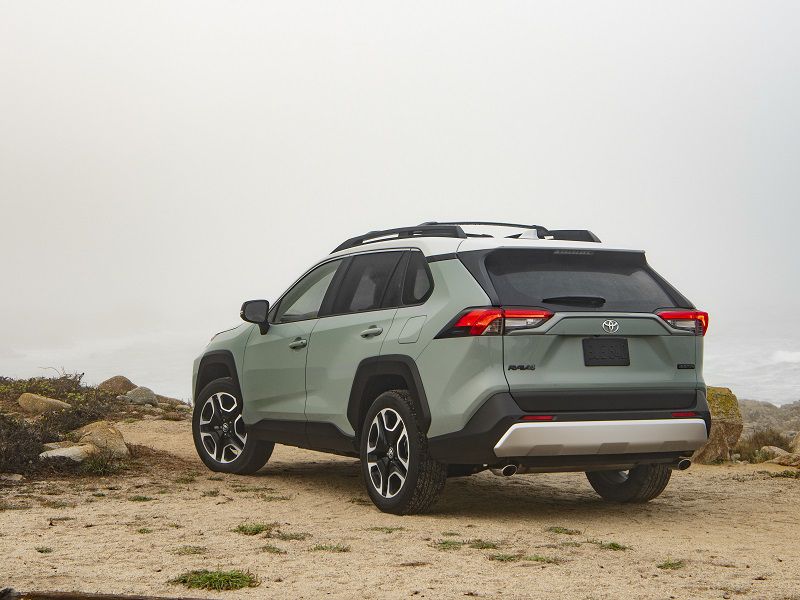
Photo by Toyota